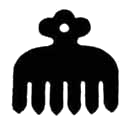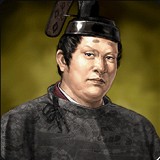

今川 義元
いまがわ よしもと
Imagawa Yoshimoto
1519 - 1560
 
Appearances: Sengoku Musou (1Moushouden), Sengoku BASARA (1NPC,2NPC)
Imagawa Yoshimoto was the daimyô of Suruga and Tôtomi and, later, Mikawa Provinces until 1560. He is most known for losing to Oda Nobunaga at the Battle of Okehazama.
Yoshimoto was the 5th son of 今川上総介氏親 Imagawa Kazusa no suke Ujichika .As a youth he was sent to the Zentoku-ji to prepare for a religious life. In 1526 Ujichika died and his eldest son 氏輝 Ujiteru succeeded him. Ujiteru himself died of illness in 1536 and this touched off a struggle for power between his remaining brothers. Yoshimoto quit the temple and entered the fray, which became known as the 花倉の乱 Hanagura no Ran. Yoshimoto emerged the victor with the aid of Hojo Ujitsuna, and moved to consolidate his power with a marriage to 武田信虎 Takeda Nobutora's sister in 1537.
Concerned by the proximity of Kai to his own domain, Yoshimoto sought to influence the Takeda and was apparently involved in Takeda Shingen's take-over in 1540. For a time he enjoyed the friendship of the Takeda and marched against the Hojo in 1544. In this instance he was unable to make progress and arranged a peace treaty after facing Hojo Ujiyasu at Kitsunebashi. A brilliant administrator, Yoshimoto carried out a series of land surveys and transformed his capital of Sumpu into a cultural center. Yoshimoto himself was said to have had the habit of shaving his eyebrows and blackening his teeth in the manner of a Kyoto noble.
Militarily, Yoshimoto worked towards consolidating the Imagawa domain and was greatly aided by his uncle, the monk-general Sessai Choro (aka. 太源雪斎 Taigen Sessai). He secured Imagawa influence over Tôtomi and made a series of political maneuvers that led to the submission of the Matsudaira in 1548 and the acquisition of the future Tokugawa Ieyasu as a hostage. In his westward expansion, Yoshimoto came into conflict with the Oda of Mikawa, and fought with them on a number of occasions, including the Battle of 小豆坂 Azukizaka in 1542 - which Yoshimoto lost. Yoshimoto was afterwards content to leave the fighting to Sessai.
Yoshimoto's greatest gifts, however, lay within the political realm, and in 1545 he engineered a three way union between the Takeda, Hôjô, and Imagawa, famously known as the 三国同盟 Sangoku Doumei (Three Kingdoms Alliance). Yoshimoto was clearly respected by his peers, and was often in the position of mediator - such as when Hôjô Ujiyasu requested he ask Takeda Shingen not to attack Kozuke as the Hôjô were preparing to do so.
By the close of the 1550's, Yoshimoto enjoyed a strong position and began to consider marching on Kyoto. Sessai had died in 1557, but the Imagawa had been able to call on the talents of the young Matsudaira Motoyasu (later Tokugawa Ieyasu) to check the activities of Oda Nobunaga, and by 1560 Yoshimoto felt confident enough to call his entire army to arms. He mustered somewhere between 15,000 and 20,000 men from Suruga and Mikawa and in June 1560 departed for Kyoto. Two of Oda's forts (Marume and Terabe) were reduced, and a confident Yoshimoto called for his men to rest in the Dengakuhazama (near Okehazama).
Unbeknownst to the Imagawa, Oda Nobunaga had resolved to take the offensive, and had managed to creep right up on Yoshimoto's encampment. Following a terrific thunderstorm, Oda's men attacked, and such was the suddenness and violence of their charge Yoshimoto initially assumed a fight had broken out among his men. Amidst the growing confusion, Yoshimoto was set upon by a number of Oda warriors. He managed to cripple one with a blow of his sword, but was struck down by a certain Mori Shinsuke.
When word of his death spread, the Imagawa army fled precipitously, signaling not only the end of Yoshimoto but also an eventual end to the Imagawa. Indeed, his successor Ujizane would suffer the loss of his lands to the Tokugawa and Takeda by 1569, and in the end retired to Kyoto.
Yoshimoto composed the Imagawa kana mokuroku tsuika (expanding on house rules left by Ujichika) in 1553. He established a printing press in Sumpu and oversaw the completion of a five-volume history of the Imagawa family.
Biography created by: ZhouTai50
| | |